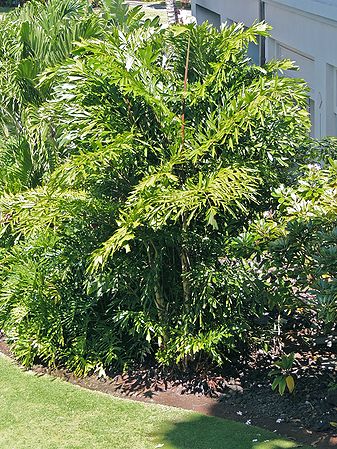Pronunciation: care-ee-OH-tuh MY-tiss
Common Name: Clustering Fishtail Palm
Caryota mitis is a fairly commonly available Caryota in California and is the only suckering species in cultivation in California though suckering Caryotas show up that don't seem to fit this species exactly. Though commonly grown, does not always look good in California (gets an untidy look, particularly after some stems start dying post flowering)- needs humidity, some protection from hot sun, and burns in cold. Stems dies after flowering but plant keeps on living sending up new offsets. Variegated forms not all that uncommon.
|
Appearance and Biology
- Habit: clustering with a crown of 6-10 bipinnate fishtail leaves
- Height: 15'
- Trunk: multiple; densely clustered; 4"-6" thick; grey; ringed with wide internodes; slight fiber above any retained leaf bases, but lower stems clean
- Crownshaft: none
- Spread: 12'-20'+
- Leaf Description: bipinnate; mostly upright to about 45 degree angles; 6'-8' long; bright green; leaflets narrowly wedge-shaped with premorse ends (fishtail) and pendent
- Petiole/Leaf bases: 12"-18" long; nearly tubular; unarmed; pale green to yellowy-green; un-split
- Reproduction: monoecious; monocarpic (each stem dying after flowering fully)
- Inflorescence: below leaves; no new leaves once begins flowering; as new inflorescences form (from bottom to top of trunk) leaves immediately above begin to die; pendent; 12"-16" long; many simple branches
- Fruit: olive green turning red to dark red-black when ripe; spherical; 1/2"; toxic oxalates in fruit
|
Horticultural Characteristics
- Minimum Temp: 28F
- Drought Tolerance: moderate to poor (tolerates some, but looks bad)
- Dry Heat Tolerance: moderate to poor
- Cool Tolerance: low to moderate
- Wind Tolerance: poor
- Salt Tolerance: low
- Growth Rate: very slow to slow with age
- Soil Preference: widely adaptable
- Light Requirement: shade to full sun (looks better with some sun protection)
- Human Hazards: toxic fruits (oxalates)
- Disease or Horticultural Problems: tends to look ratty in dry, windy conditions (prefers high humidity)
- Transplants?: unknown
- Indoor?: moderately good
- Availability: somewhat rare, but shows up at normal nurseries now and then
|
























